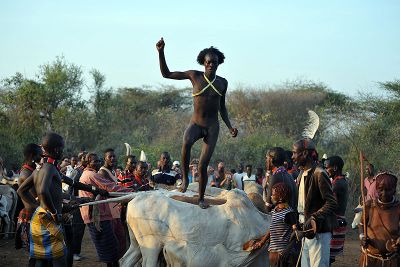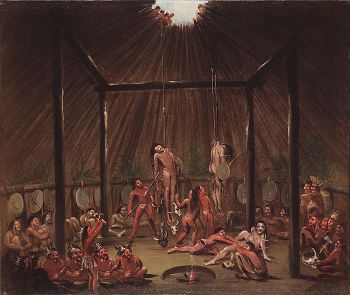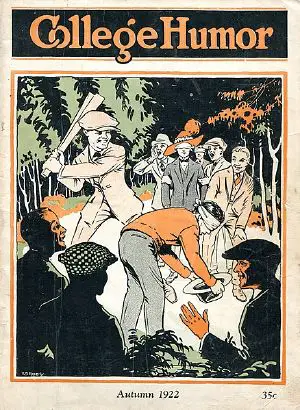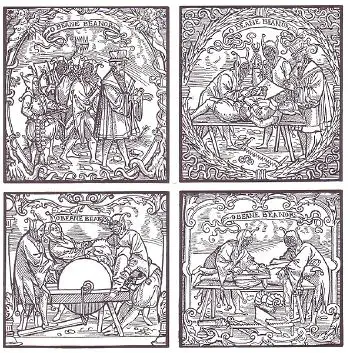Initiation

Initiation is a rite of passage marking entrance or acceptance into a group or society. It could also be a formal admission to adulthood in a community or one of its components. In an extended sense it may also signify a transformation in which the initiate is "reborn" into a new role. The initiation experience tends to bring new members closer to the group, developing social cohesion, and increasing their commitment both to the other members and the purpose of the group.
The components of the initiation vary widely from study of scripture and public affirmation of faith, through tests of knowledge or physical fortitude, to participating in humiliating, dangerous, or even criminal activities. Examples of initiation ceremonies include Christian baptism or confirmation, Jewish Bar or Bat Mitzvah, acceptance into a fraternal organization, secret society, or religious order, or graduation from school or recruit training.
Characteristics
Initiation rituals have been theorized to lead to the development of social cohesion though group identification and identity fusion.[1]
Studies of certain social forms of initiation, such as hazing in college fraternities and sororities, suggest that severe initiations produce cognitive dissonance.[2] Dissonance is then thought to produce feelings of strong group attraction among initiates after the experience, because they want to justify the effort expended.[3] A 2017 study found that groups that share painful or strong negative experiences can cause visceral bonding, and pro-group behavior. For example, students of Brazilian Jiu Jitsu who had experienced painful belt-whipping gauntlets had a higher willingness to donate time or risk their lives for the club.[4]
On the other hand, rewards during mild initiations have important consequences in that initiates who feel more rewarded express stronger group identity: A reward led to higher group identity than no reward. ... Interestingly, a mild initiation followed by a reward led to more group identity than a severe initiation followed by a reward.[5] Such findings support the idea of group socialization proposed by Levine and Moreland in which the relationship between the individual and the group "is assumed to change in systematic ways over time and both parties are viewed as active social influence agents."[6]
As well as group attraction, initiations can also produce conformity among new members.[7] Psychology experiments have also shown that initiations increase feelings of affiliation.[8]
Mircea Eliade defined initiation as "a basic change in existential condition," which liberates man from profane time and history. "Initiation recapitulates the sacred history of the world. And through this recapitulation, the whole world is sanctified anew... [the initiand] can perceive the world as a sacred work, a creation of the Gods."[9]
Eliade noted a variety of functions fulfilled by initiation rituals:
- "this real valuation of ritual death finally led to conquest of the fear of real death."
- "[initiation's] function is to reveal the deep meaning of existence to the new generations and to help them assume the responsibility of being truly men and hence of participating in culture."
- "it reveals a world open to the trans-human, a world that, in our philosophical terminology, we should call transcendental."
- "to make [the initiand] open to spiritual values."
Types
Eliade described several types of initiation:[9]
- Puberty rites: Rituals "by virtue of which adolescents gain access to the sacred, to knowledge, and to sexuality‚ÄĒ by which, in short, they become human beings." These are "collective rituals whose function is to effect the transition from childhood or adolescence to adulthood." They represent "above all the revelation of the sacred."
- Initiation into a mystical vocation: "the vocation of a medicine man or a shaman." This is limited to the few who are "destined to participate in a more intense religious experience than is accessible to the rest of the community."
- Entering into a Secret society
- Other specialized initiations.
Examples
Religious and spiritual

A spiritual initiation rite normally implies a shepherding process where those who are at a higher level guide the initiate through a process of greater exposure of knowledge. This may include the revelation of secrets, hence the term secret society for such organizations, usually reserved for those at the higher level of understanding. One famous historical example is the Eleusinian Mysteries of ancient Greece, thought to go back to at least the Mycenaean period or "Bronze Age."
In the context of ritual magic and esotericism, an initiation is considered to cause a fundamental process of change to begin within the person being initiated and its "evolution operates within both the material world and the spiritual world."[10] The person conducting the initiation (the initiator), being in possession of a certain power or state of being, transfers this power or state to the person being initiated. Thus the concept of initiation is similar to that of apostolic succession. The initiation process is often likened to a simultaneous death and rebirth, because as well as being a beginning it also implies an ending as existence on one level drops away in an ascension to the next.
Initiation is a key component of Judaism, Sufism, and Shia Islam, Vaishnavism, Sant Mat, Surat Shabd Yoga, Vajrayana Buddhism, Wicca, and similar religious gnostic traditions. It denotes acceptance by the Guru and also implies that the Chela (student or disciple) agrees to the requirements (such as living an ethical lifestyle, meditating, and so forth).

Some communities on board a military vessel and also of military soldiers tend to form a closed "family" which absorbs in members, who are often formally accepted after some kind of test or hazing.
In addition, there can be similar rites of passage associated with parts of naval and military life, which do not constitute true initiations as the participants are already and remain members of the same community. One such rite is associated with crossing the equator on board a naval ship, but it can even be taken by passengers on board a cruise liner, who are not and do not become members of anything but the so-called "equator crossing club."
College Fraternities and Sororities
Traditionally, college fraternities and sororities conduct initiation rituals known as hazing for potential new members ("Pledges"). Hazing activities can involve forms of ridicule and humiliation within the group or in public, while other hazing incidents are akin to pranks. A "snipe hunt" is such a prank, when a newcomer or credulous person is given an impossible task, such as being sent to find a tin of Tartan paint, or a "dough repair kit" in a bakery.[11]
Spanking may be involved, mainly in the form of paddling, sometimes over a lap, a knee, furniture, or a pillow.
Submission to senior members of the group is common, often with meaningless tests of obedience such as waiting on others (as at fraternity parties) or various other forms of housework. In some cases, the hazee may be made to eat raw eggs, peppers, hot sauce, or drink too much alcohol. Some hazing even includes eating or drinking vile things such as bugs or rotting food.[12]
Gangs
Gangs often require new members to commit crimes before accepting them as part of the gang:
In some New Guinean tribes when a boy wants to become a man, he should go to enemy‚Äôs village and kill a pig. After that his community will accept him as an adult. In industrial Port Moresby women have replaced pigs. ‚ÄúFirst, a young gang member should steal something, money or a car ‚ÄĒ and he will be admitted to the gang. After that he must prove that his intentions are serious and he must rape a woman to complete his initiation. And it is better if a boy kills her afterwards, there will be less problems with the police,‚ÄĚ one of the leaders of ‚ÄúDirty Dons 585‚ÄĚ Raskol gang, Peter Moses, revealed.[13]
New members may be physically beaten (also known as a "beat-in" or a "jump-in") by fellow gang members to demonstrate their courage, willingness, and loyalty. Female members may be required to have sex with male members as a form of initiation, also known as "sex in," though they may also be "jumped-in" like their male counterparts. Female members who were ‚Äúsexed-in‚ÄĚ as part of gang initiation were often viewed with lower respect than those that were "jumped-in," even when promised they would become full-fledged members.[14] Sexed-in members also face greater risk of sexual exploitation and abuse by fellow male members.[15]
Tribes
Tribes often have initiations, although in contemporary times where modernization has occurred, initiation is often not taken as seriously as before. Initiation may be thought of as an event which may help teens prepare themselves to be good husbands and wives. In some African tribes, boys take about 3‚Äď4 months participating in initiation rites and girls take about 1‚Äď2 months.
In many African tribes, initiation involves circumcision of males and sometimes genital mutilation of females as well. For example, the initiation done in the Bapedi tribe of South Africa is normally regarded as a stage where a boy is to be taught manhood and a girl to be taught womanhood. Initiation is considered necessary for the individual to be regarded as a full member of the tribe. Otherwise, the individual may not be allowed to participate in ceremonies or even in social rituals such as marriage: A man will not be allowed to marry or have any special relationship with a woman who did not go to an initiation, because she is not considered to be a woman.

The Hamar tribe in Ethiopia are known for their unique custom of "bull jumping," which initiates a boy into manhood. The boy must run back and forth twice across the backs of a row of bulls or castrated steers, and is ridiculed if he fails.[16]
Australian Aboriginal tribes usually had long periods of time to help prepare adolescent boys, teaching them traditional lore before they were ready to attend large elaborate ceremonies at the time of initiation when they were finally recognized as full-fledged men in their society. Most tribes had circumcision and scarification as part of the male initiation rituals, while many Central Australian tribes also practiced subincision.
The Sateré-Mawé people of Brazil use intentional bullet ant stings as part of their initiation rites to become warriors.[17]

The Lega people are a Bantu ethnic group of the Democratic Republic of the Congo. They traditionally live in small village groups, with no central authority. Within a community, a chief inherits his position on a patrilineal basis, and his close relatives have highest rank. Counterbalancing this hereditary structure, the Bwami society also regulates social and political life. This society has seven levels for men and four for women and is open to all. An initiate advances through the ranks through a complex system of instruction, payment, and initiation, achieving increasing status. A member of the highest level is recognized as a Kindi, a social leader with great moral authority.[18]
A salient shared cultural feature of the Min peoples of the New Guinea Highlands is initiation into a secret male religious cult.[19] For example, the Urapmin people used to practice a type of male initiation known in as ban, which involved elaborate rituals that were a central part of Urapmin social life. The ban was a multistage process which involved beatings and manipulation of various objects. At each stage, the initiate was offered revelations of secret knowledge (Urap: weng awem), but at the next stage these would be shown to be false (Urap: famoul). These initiations were abandoned with the adoption of Christianity, and the Urap have expressed relief at no longer having to administer the beatings which were involved.[20]
Universities
The deposition (from Latin depositio cornuum, "taking off the horns") was a semi-official initiation ritual which was common at universities throughout Europe from the Middle Ages until the eighteenth century.[21] The basis for the deposition was the idea that the arriving student was still wild and unpolished before his matriculation ‚Äď like an animal ‚Äď and had to be relieved of the signs of his uncivilized state before he could be accepted as part of the University. The student only had to go through the deposition once in his life; he would receive a deposition certificate (Depositionsschein in German) which he could show in case of transferring to another university.
The deposition consisted of scolding, in which the unworthiness of the new student would be clarified to him, in ritual removal of animal-like artificial body parts with the help of over-dimensioned tools, as well as beating and other abuse, which would have the function of a purification ritual.
In the speeches at the ritual, models from classical antiquity for the deposition process would be cited. Reference would be made to the examination of the Spartan youth, to the customs of the Academy of Plato, and the water consecration among the Athenian Sophists of Late Antiquity.
The arriving student would in the Middle Ages be known by the term beanus, derived from the French bec jaune, "yellow beak" (cf. English "greenhorn"). The beanus would be treated by his new fellow students as a pecus campi ("animal of the field") and outfitted correspondingly. He would have to don a hood with horns and put the teeth of a boar sticking out of his mouth. He would then have to listen to a speech about his own unworthiness. The animal-like traits would then be knocked off with the help of over-sized tools. The body of the student would be additionally abused, symbolizing the cleansing and beautification. During the process wood-working tools would be used, as the student still was an "uncouth man" (German ungehobelt, unplaned).
At the University of Leipzig, the tools used in the deposition ritual are still preserved and kept in the art collection. The tools include those used for knocking off or polishing away the animal-like parts (axe, pliers, grindstone), tools for woodworking (plane), and for personal hygiene (shaving brush, shaving cream, shaving knife, ear spoon). Injuries to new students were common with the use of these tools.
After this, examinations would be carried out, and additional speeches of admonition would be held. Finally, the leader of the ritual would put salt in the mouth of the beanus (sal sapientiae, "salt of wisdom"), pour wine over his head (vinum laetitiae, "wine of joy") and declare him free of his "beanism." After the payment of the relevant fee, an entrance examination would follow, carried out by a professor, and the matriculation by the rector of the university.
Notes
- ‚ÜĎ Harvey Whitehouse and Jonathan A. Lanman, The Ties That Bind Us Current Anthropology 55(6) (2014): 674‚Äď695. Retrieved June 15, 2022.
- ‚ÜĎ Elliot Aronson and Judson Mills, The effect of severity of initiation on liking for a group Journal of Abnormal and Social Psychology 59(2) (1959): 177‚Äď181. Retrieved June 14, 2022.
- ‚ÜĎ Leon Festinger, The psychological effects of insufficient rewards American Psychologist 16(1) (1961): 1‚Äď11. Retrieved June 14, 2022.
- ‚ÜĎ Harvey Whitehouse, Jonathan Jong, et al., The evolution of extreme cooperation via shared dysphoric experiences Scientific Reports 7 (2017):44292. Retrieved June 15, 2022.
- ‚ÜĎ Caroline Kamau, What does being initiated severely into a group do? The role of rewards International Journal of Psychology 48(3) (2013): 399-406. Retrieved June 14, 2022.
- ‚ÜĎ John M. Levine and Richard L. Moreland, Group Socialization: Theory and Research European Review of Social Psychology 5(1) (1994): 305-336. Retrieved June 14, 2022.
- ‚ÜĎ Caroline F. Keating, Jason Pomerantz, et al., Going to college and unpacking hazing: A functional approach to decrypting initiation practices among undergraduates Group Dynamics: Theory, Research, and Practice 9(2) (2005): 104‚Äď126. Retrieved June 14, 2022.
- ‚ÜĎ Hein F. M. Lodewijkx, Martijn van Zomeren, and Jef E. M. M. Syroit, The anticipation of a severe initiation: Gender differences in effects on affiliation tendency and group attraction Small Group Research 36(2) (2005): 237‚Äď262. Retrieved June 14, 2022.
- ‚ÜĎ 9.0 9.1 Mircea Eliade, Rites and Symbols of Initiation (Spring Publications, 1965. ISBN 978-0882140612).
- ‚ÜĎ Christian Bernard, So Mote It Be! (Rosicrucian Order, AMORC, 2004, ISBN 978-1893971073).
- ‚ÜĎ Reinhold Aman (ed.), Maledicta 12 (Maledicta Press, 1996, ISBN 978-0916500320).
- ‚ÜĎ Chris Glavin, Hazing Methods K12 Academics. Retrieved June 16, 2022.
- ‚ÜĎ Vlad Sokhin, Crying Meri: Violence Against Women in Papua New Guinea Retrieved June16, 2022.
- ‚ÜĎ Deborah Burris-Kitchen, Female Gang Participation (Edwin Mellen Press, 1997, ISBN 978-0773486171).
- ‚ÜĎ Winifred L. Reed and Scott H. Decker, Responding to Gangs: Evaluation and Research (National Institute of Justice, July 20020. Retrieved June 16, 2022.
- ‚ÜĎ Jane Wharton, The making of a man: Inside a bull jumping ceremony with Ethiopia's Hamer tribe The Express, February 22, 2015. Retrieved June 16, 2022.
- ‚ÜĎ Steve Backshall, Bitten by the Amazon The Sunday Times, January 6, 2008. Retrieved June 16, 2022.
- ‚ÜĎ Daniel P. Biebuyck, Lega Culture: Art, initiation, and moral philosophy among a Central African people (University of California Press, 1973, ISBN 978-0520020856).
- ‚ÜĎ Robert C. Brumbaugh, Models of Separation and a Mountain Ok Religion Journal of the Society of Psychological Anthropology 8(4) (Winter 1980): 332-348. Retrieved June 16, 2022.
- ‚ÜĎ Joel Robbins, Becoming Sinners: Christianity and Moral Torment in a Papua New Guinea Society (University of California Press, 2004, ISBN 978-0520238008).
- ‚ÜĎ Michael Waters, A Violent 15th-Century Freshman Hazing Ritual Involving Boar Tusks and Razors Atlas Obscura, July 10, 2017. Retrieved June 17, 2022.
ReferencesISBN links support NWE through referral fees
- Aman, Reinhold (ed.). Maledicta 12. Maledicta Press, 1996. ISBN 978-0916500320
- Bernard, Christian. So Mote It Be!. Rosicrucian Order, AMORC, 2004. ISBN 978-1893971073
- Biebuyck, Daniel P. Lega Culture: Art, initiation, and moral philosophy among a Central African people. University of California Press, 1973. ISBN 978-0520020856
- Burris-Kitchen, Deborah. Female Gang Participation. Edwin Mellen Press, 1997. ISBN 978-0773486171
- Eliade, Mircea. Rites and Symbols of Initiation. Spring Publications, 2017 (original 1965). ISBN 978-0882140612
- Robbins, Joel. Becoming Sinners: Christianity and Moral Torment in a Papua New Guinea Society. University of California Press, 2004. ISBN 978-0520238008
External links
All links retrieved November 30, 2024.
- Initiation Rites in Africa Geography
- Initiation and Rites of Passage Wilderness Quest
- Why would you do this? BBC Two: Extraordinary Rituals
Credits
New World Encyclopedia writers and editors rewrote and completed the Wikipedia article in accordance with New World Encyclopedia standards. This article abides by terms of the Creative Commons CC-by-sa 3.0 License (CC-by-sa), which may be used and disseminated with proper attribution. Credit is due under the terms of this license that can reference both the New World Encyclopedia contributors and the selfless volunteer contributors of the Wikimedia Foundation. To cite this article click here for a list of acceptable citing formats.The history of earlier contributions by wikipedians is accessible to researchers here:
The history of this article since it was imported to New World Encyclopedia:
Note: Some restrictions may apply to use of individual images which are separately licensed.


